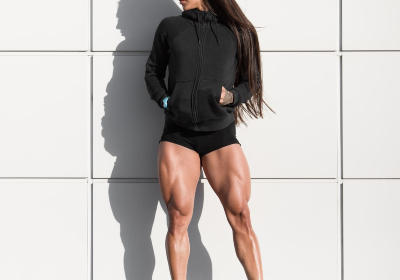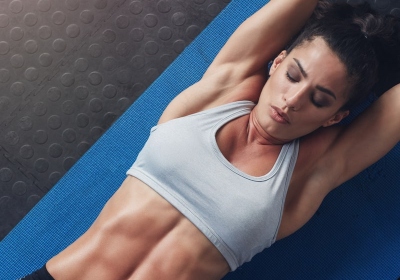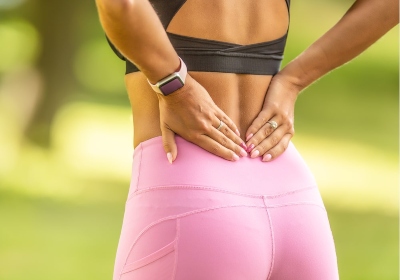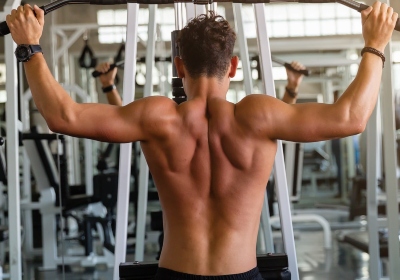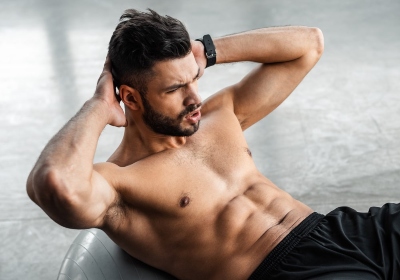VIDEO
Kettlebell Forward Lunge
- Core
- Upper Back
- Lower Back
- Shoulders
- Gluteus
- Quads
Level:Intermediate
Trainer:Nick Taylor
Equipment:Kettlebell
Kettlebell Forward Lunge
- Core
- Upper Back
- Lower Back
- Shoulders
- Gluteus
- Quads
Level:Intermediate
Trainer:Nick Taylor
Equipment:Kettlebell
Stand straight with kettlebell in the right hand, and feet shoulder's width apart. Step forward with the right leg into the lunge position, and lower the left knee almost to the floor. Keep your back straight and do not touch knee. At the bottom of the lunge pass the kettlebell between the legs to the other hand. Stand upright getting back to starting position and repeat with opposite leg.
save to ...
RECOMMENDED FOR YOU
ARTICLES
One of the most important running muscles is the quadriceps - the large muscle at the front of the thigh. It has been scientifically proven that regular strength training improves workout performance and reduces the risk of injury, as well as strengthens your back, and leg muscles, making your running more productive.
The quads, also known as the quadriceps muscle, is a group of muscles located at the front of the leg above the knee. It is one of the largest and strongest muscles in your body that consists of four heads: fastus medialis (medial wide), vastus intermedius (intermediate wide), vastus lateralis (lateral), and rectus femoris (straight thigh muscle). Almost every action performed by the legs involves two or more heads of the quadriceps. The quadriceps muscle plays an important role at the beginning of the movement (quick start) and during ascent and descent in elevated positions - which is why you may experience painful sensations in this area of the leg after an intense uphill workout.
According to researchers at the University of Delaware, strong quadriceps act as cushioning and can protect the knees and the entire musculature of the hip from common running injuries. Often many runners are injured because they have weak and underdeveloped quadriceps, so it is especially important to strengthen them.
By training and strengthening the quads, you can get the following benefits when running:
Increased speed. Strong quadriceps help you tackle steep hills and climbs more easily and make pushing off the ground more powerful, resulting in increased speed.
Reduced injuries. According to research, poorly developed quadriceps are often associated with many running injuries. For example, a common injury such as the 'runner`s knee' results from weakness in these muscles, which are unable to stabilize the knee joint during the movement.
Increased endurance. Strengthening the quadriceps muscle will make your running more effortless and efficient, which contributes to increased running volume and endurance.
Training
The quadriceps occupy 70% of the muscle mass of the leg, so it is their development that is fundamental in leg training. The main exercise for developing the quadriceps is the squat. But, for beginners, at the first stages of training, it is better to start with leg curls sitting in an exercise machine, leg press, and hyperextensions to strengthen the lower back, to avoid injuries, in order to prepare the base for the heavy squats. It is a good idea to include squats in your training plan after about six months of training.
Read more
The core is a series of muscles that start under the pectoral and extend to the pelvis. It also includes several groups in the back and other groups throughout the torso. A 'strong back' means a good physique and a healthy body. If you want to learn how to do this, learn to exercise at home or at the gym. Once you have achieved this strength, you can also learn to maintain it.
The midsection is the area of the body often referred to as the core and it involves everything in that area including the front, back and sides. It includes:
lower back.
the traverse abdominis (TVA);
erector spinae;
obliques;
If they are week it could cause lower back and waist pain. However, taking care of them can keep your posture healthy and make you stronger in other exercises like running and walking.
Training. One of the best core exercises is a plank. It provides minimal movement but maximal effort, demanding you to support your body on your hands and toes during holding your body in a straight line from your shoulders to your ankles. Also, you can rest on your knees If you need it or make it more difficult by extending your arms so you’re supported by your hands.
Bridge. Lie down on the floor. Put your arms straight down on the floor near your hips. Bend your knees. Lift your hips up and down.
Superman. Do a little push-up. Lie with your face down and stretch and arms forward and your legs backward.
V-Jumps. Sit on a bench or chair, lift your legs, tilt the core slightly forward so that your body forms a 45-degree angle. From this position jump up extending your hands above your head.
Pushup Variation. Put your hands and toes on the mat. Keep your arms straight, but don't lock your elbows. Align your feet making the straight line with your arms. Inhaling, lower your chest to the ground slowly. Straighten your arms to lift your core up, exhaling.
Inchworm Variation. Put your hands on the ground and your feet - on the elevated surface (a bench). Start walking your hands out, as far as you can keeping your legs straight throughout the movement. Make a pause. Walk your hands back up to the starting position.
Reverse Crunches Variation. Bend your legs at the knees and brace your abs to slowly raise your legs so that your knees are directly over your hips. Brace abs and hold the neutral spine position with a slight neutral curve in the lower back. Exhale as you contract the abs Your head should be kept straight and relaxed on the mat. Inhale and slowly return to the starting position.
Read more
Your lower back includes the 5 vertebral bones that are placed on top of each other with intervertebral discs. The bones are connected there using unique joints. The lumbar spine is matched with the thoracic region above and the thighs below.
Individual anatomical structures include :
Vertebrae. It protects important nerve tissues such as the spinal cord and cauda equina.
Disks. The discs usually provide cushioning and cushioning to protect the vertebrae during spinal movements.
Facet joints give a little stability and allow the spine to move in various directions. The facets of the upper lumbar vertebrae are almost the same as the facet joints of the chest and, as it was already written, the main aim is controlling the movement of the spine.
The facets of the lumbar are more flexible and facilitate side-to-side movement.
The large muscles and complex network of ligaments support serve to stabilize it and enhance your twisting and bending movements.
The lumbar supports most of the body. A lot of people feel this kind of pain at some point sometimes. Sedentary muscle atrophy is common, especially if you work in an office and lead a relatively sedentary lifestyle. If you want to make your lower back stronger, start with a regular training program that consists of strength training, stretching, and aerobics or cardiovascular exercise.
Training
Child's pose. Get on all fours and stretch your arms out in front of you. Gently lower your buttocks to your heels. Lower your head to the floor and push your palms forward until your arms are fully extended. Stay in this position for 30 seconds.
Lunges. Lunge with your right foot forward, rest on your hands. Please note that the right hand should be to the left of the leg. Step your right foot about the width of your right hand. Next, without moving your arms, swing your hips forward to stretch the front of the thighs, and hold in this position for 30 seconds. Do the same with the other leg.
Seated crunches. Sit with your legs straight, then bend your knees and bring your left leg over your right, placing it on the outside of your right thigh. Pull your right foot closer to your right buttock. Next, bend your right arm at the elbow and put it behind your left knee, as if keeping yourself twisted. Hold this position for 30 seconds. and repeat the same for the other leg.
Happy child. Lie on the floor, as you exhale, pull your knees to your stomach. As you inhale, grab the outer sides of your feet with your hands. Slightly spread the knees to the sides slightly wider than the body, pull the knees to the armpits. Make sure your shins are perpendicular to the floor. Hold this pose for 30 seconds.
Twisting. Lie on the floor and bend your knees, take your legs to the side, for example to the right. In this case, the left leg should lie on the floor, and the right ankle should be above the left knee. Place your hands next to your head, with your right knee strive downward (to the floor). Stay in this position for 30 seconds. alternately for each side.
Read more
The most important muscles in the upper back are the lats and trapezius.
Lats (Latissimus dorsi). Shaping muscles of the back, giving the figure a tapered appearance. Visually widen the shoulders and make the waist appear narrower. They are located on both sides of the spine, and their shape resembles a wing.
Trapezius muscles. These are the muscles that need to be trained if you want to correct the slouch. Responsible for the movement of the scapula. They have a triangular shape; in the upper part, they are attached to the back of the head, in the lower part - to the spine.
Be careful, ‘cos back exercises are some of the most traumatic. In the early stages, use light weights to strengthen the ligaments and muscles to protect the spine. After mastering the technique, gradually and very gently increase the weight.
The upper and horizontal rows are the exercises closest to the anatomical movement of the joints.
Training
Wide grip pull-ups. Pulling up is one of the main exercises for back muscle growth, performed with body weight. First, learn how to pull up correctly, and only then move on to training with dumbbells or a barbell. It is important that when performing the exercise, you should feel the work of the back muscles, not the biceps. Grab the horizontal bar with an upper grip, arms slightly wider than shoulder-width. When pulling up, try to pull the body up not with your hands, but with your back. Pause for a second at the top point, smoothly return to the starting position.
Upper block thrust. The exercise imitates pulling up, go to it only when you learn to pull up, and you can do it at least 8-10 times per set. Important: pulling the bar towards your chest, not your head - this will reduce the dangerous load on your shoulders, a signal of improper performance - to feel the work of the hands. If you can't feel your back, use less weight. increase the width of the grip every time - this has a positive effect on the 'growth' of the back.
Seated pulldown. A basic exercise that includes a large muscle mass, especially the pectorals and lats. One of the best for giving the back a visual width. With a straight bar (see photo), the trapezius muscles are also included in the work.
Make sure that the cable is parallel to the floor during the exercise, the torso does not change the slope, and the back is straight.
Shrugs. Almost the only exercise for isolated work on the trapezius muscles. There are many variations - with dumbbells, with a barbell, standing, sitting or lying down. The photo shows an option sitting on a bench with dumbbells.
When lifting the dumbbells up, you can lower your chin slightly, which will increase the load on the muscles. It is important not to rotate your shoulders or relax them at the bottom of the exercise - this is very dangerous for the joints.
One-arm dumbbell row. Place your knee and hand on the bench. Take the dumbbell with your other hand, pull it as close to your chest as possible, then slowly lower it down. Make sure that your back is parallel to the floor during the exercise, do not round it; do not drop your non-working shoulder.
Important:
As soon as the elbow is at shoulder level, connect the shoulder to the movement - pull it up with the elbow. This will maximize the contraction of your mid-back and upper lats.
If you are having trouble getting your elbow higher than your shoulder, use a lighter dumbbell.
Read more
Since ancient times, developed muscles have been one of the hallmarks of a harmoniously developed, athletic body. There is no such thing as 'abs' in anatomy. This is a conditional abdominal muscle. There are four of them:
rectus;
internal oblique;
external oblique and transversus.
The rectus abdominis muscle is the largest in area. It’s a popular fallacy that there is a 'lower' and 'upper' press, but the rectus muscle does not have such a division. The notorious 'six-pack' stands out because of the tendon bridges on the rectus abdominis muscle. The muscle bundles of the external abdominal muscle begin from the lower eight ribs and extend radially downward. The transverse muscle is located deeper than the other abdominal muscles. In this case, the tendon extension in the upper two-thirds passes behind the rectus muscle, and in the lower third - in front. Partly because of this, the lower abs are less workable than the upper ones. The abdominal muscles are referred to as the core muscles, the muscle complex responsible for stabilizing the spine, pelvis, and hips. Each of the abdominal muscles is responsible for its own functions. One of the most common fallacies in abdominal training is that the more reps we do in a set, the stronger and bigger the abs will be. In fact, the muscles of the abs are no different in terms of training from the biceps. To increase the biceps, you will do one hundred reps per set. However, you will reduce the number of sets and reps, but increase the load. By increasing the number of repetitions in the set, you will develop strength endurance, but the muscle will not get thicker from this. It is much more effective to increase the load, do sets with weights and reduce the number of repetitions in the set. Three factors affect the appearance of your abs: posture, body fat percentage, and muscle development.
Posture.If a person pumps muscles but slouches, and he has excess fat, then the abs will not be visible. If a person does not pump the abs, but he has a good posture and a small percentage of body fat, then his belly will look flatter. That is why it makes no sense to start with the question of how to properly pump the abs. You need to start by working on your posture. The good news is that your core muscles are also responsible for correct posture. And they are usually used in workouts with an emphasis on the abs.
Fat percentage.Measuring body composition on an analyzer scale will show the percentage of body fat, which explains why the abs are invisible. If the fat is more than 15-20%, then it’s hard to see your six-pack. At 15% or less, the abs begin to be seen. 8% is abs athletes have. But do not try to completely get rid of fat for beautiful abs. Fat is necessary for the proper functioning of the endocrine system and other processes in the body. To achieve tangible results, it is important to monitor the factors that affect the percentage of body fat like food, sleep, stress levels, and the amount of daily physical activity.
Muscle development.You mustn’t focus only on abs exercises, you need to develop the body complexly and do a variety of activities. Strength training will strengthen your muscles, burn calories and build endurance with interval training. Recovery activities help with posture, flexibility, and muscle balance. The optimal training program can be selected after fitness testing, which takes into account how a person moves, what restrictions he has.
Read more
SAVE TO ...

